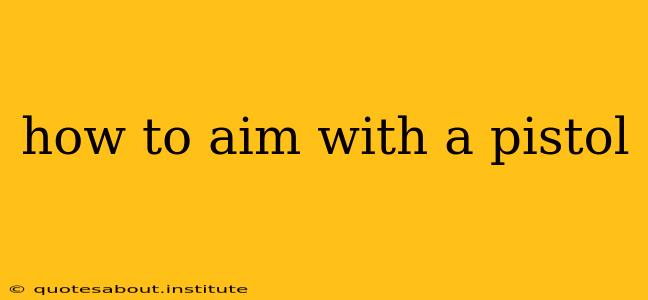Pistol shooting, whether for sport, self-defense, or hunting, demands precision and control. Mastering the art of aiming is paramount to achieving consistent accuracy. This guide breaks down the essential techniques and principles to help you improve your pistol aiming skills, regardless of your experience level.
Understanding the Fundamentals of Pistol Aiming
Before diving into specific techniques, let's establish a foundational understanding of what constitutes proper pistol aiming. It's not just about pointing the gun; it's about aligning your sights with your target in a controlled and repeatable manner. This involves several key components:
1. The Sight Picture: The Foundation of Accuracy
Your sight picture is the visual alignment of your front sight, rear sight, and target. Here's what you need to focus on:
- Front Sight Focus: Your primary focus should be on the front sight. The rear sight and target should be in your peripheral vision. A blurry front sight indicates improper focus and will directly impact accuracy.
- Sight Alignment: Ensure the front sight is centered perfectly within the rear sight's notch. Any misalignment will lead to shots landing off-target.
- Target Alignment: Once the front and rear sights are aligned, check that this alignment is also directed at your target.
2. Grip: The Key to Control and Stability
A proper grip provides stability and control, significantly impacting your aiming ability. A firm, consistent grip prevents the pistol from moving during the shot. Experiment to find what works best for you, but generally aim for:
- High on the Grip: A higher grip allows for better control and reduces muzzle flip.
- Consistent Pressure: Avoid squeezing the gun too tightly, which can lead to flinching and inaccuracy.
- Natural Point of Aim: Find a grip that allows for a natural point of aim, minimizing the need for excessive adjustments.
3. Stance: The Base for Consistent Shooting
Your stance provides stability and balance, influencing your overall aiming and shooting consistency. A solid stance is crucial for maintaining a steady aim. Common stances include:
- Isosceles Stance: Feet shoulder-width apart, arms extended, and body slightly leaning forward.
- Weaver Stance: Similar to the Isosceles but with one arm slightly more bent than the other for better recoil management.
- Modified Weaver: A variation of the Weaver stance, often preferred for its stability.
Experiment with different stances to find the one that feels the most natural and comfortable for you.
Practicing Your Aim: Drills for Improvement
Consistent practice is key to improving your pistol aiming skills. Here are some effective drills:
1. Dry Firing: Safe Practice for Skill Development
Dry firing (practicing without live ammunition) is a crucial element in building muscle memory and refining your sight picture. Always ensure the pistol is unloaded and pointed in a safe direction.
2. Target Practice: From Close Range to Further Distances
Start with close-range target practice to build confidence and refine your technique. Gradually increase the distance as your accuracy improves.
3. Slow Fire Drills: Focusing on Precision
Slow fire drills focus on controlled shots, emphasizing precise sight alignment and trigger control. This helps eliminate unnecessary movement and builds consistency.
Advanced Techniques for Enhanced Accuracy
Once you've mastered the fundamentals, consider exploring these advanced techniques:
- Breath Control: Learning to control your breathing during the shot can significantly improve accuracy.
- Trigger Control: A smooth, consistent trigger pull is essential for accurate shots.
- Follow-Through: Maintaining your sight picture and grip even after the shot helps prevent flinching and improves accuracy.
Conclusion: Dedication and Practice are Key
Improving your pistol aiming is a journey that requires dedication and consistent practice. By mastering the fundamentals, practicing regularly, and exploring advanced techniques, you'll significantly enhance your accuracy and become a more confident and skilled shooter. Remember safety is paramount, always follow proper gun safety rules and seek professional instruction when needed.

